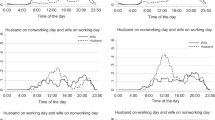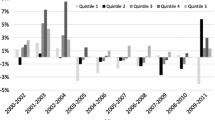Abstract
Work shifts of full-time dual-earner couples are analyzed with data from the May 1980 U.S. Current Population Survey. Over 20 percent of husbands and about 12 percent of wives work other than a regular day shift. Variations in shift work status by sex of spouse are examined according to job, race, and life-cycle characteristics. A multivariate analysis indicates that a different composite offactors affects the shift work status of husbands and wives. Given the wide variation in the prevalence of non-day employment within major groups and the sex segregation of the labor force, we look at detailed occupations and industries to the extent possible.
Similar content being viewed by others
References
Berg, I. (ed.). 1981. Sociological Perspectives on Labor Markets. New York: Academic Press.
Bunnage, D. 1979. Study on the Consequences of Shiftwork on Social and Family Life. Report, Contract EF/SC178/20/SW. Dublin, Ireland: European Foundation for the Improvement of Living and Working Conditions.
Bureau of Labor Statistics. 1981. Workers on Late Shifts. Summary 81-13 (September). Washington, D.C.: U.S. Dept. of Labor.
Carpentier, J., and P. Cazamian. 1977.Night Work: Its Effects on the Health and Welfare of the Worker. Geneva, Switzerland: International Labour Office.
Charles, N., and D. Brown. 1982. Women and Shift Work: Some Evidence From Britain. Final report, Contract EF SC 79 30-SW. Dublin, Ireland: European Foundation for the Improvement of Living and Working Conditions.
Finn, P. 1981. The effects of shift work on the lives of employees. Monthly Labor Review 104(October): 31–35.
Gannon, M. J., D. L. Norland, and F. E. Robeson. 1983. Shift work has complex effects on lifestyles and work habits. Personnel Administrator 28(May):93–97.
Ginzberg, E. 1976. The New York Times (September 12).
Hedges, J. N., and E. S. Sekscenski. 1979. Workers on late shifts in a changing economy. Monthly Labor Review 102:14–22.
Hood, J., and S. Golden. 1979.Beating time/making time: The impact of work scheduling on men’s family roles. Family Coordinator 28(October):575–582.
Lein, L., M. Durham, M. Pratt, M. Schudson, R. Thomas, and H. Weiss. 1974. Work and Family Life. Final report, National Institute of Education Project 3-3094. Wellesley, Mass.: Wellesley College Center for Research on Women.
Presser, H. B. 1984. Job characteristics of spouses and their work shifts. Demography 21:575–589.
—. 1986. Shift Work Among American Couples: The Relevance of Job and Family Factors. Pp. 149–156 in M. Haider, M. Koller, and R. Cervinka (eds.), Night and Shiftwork: Longterm Effects and Their Prevention. Frankfurt am Main: Lang.
Presser, H. B., and V. Cain. 1983. Shift work among dual-earner couples with children. Science 219:876–879.
Staines, G. L., and J. H. Pleck. 1983. The Impact of Work Schedules on the Family. Ann Arbor, Mich.: Institute for Social Research.
Tasto, D. L., M. J. Colligan, E. W. Skjei, and S. J. Polly. 1978. Health Consequences of Shift Work. Final report, Contract 210-75-0072. Washington, D.C.: National Institute for Occupational Safety and Health.
Tolbert, C., P. M. Horan, and E. M. Beck. 1980. The structure of economic segmentation: A dual economy approach. American Journal of Sociology 85:1095–1116.
U.S. Bureau of the Census. 1978. The Current Population Survey: Design and Methodology, Technical Paper 40. Washington, D.C.: U.S. Government Printing Office.
—. 1984. Household and Family Characteristics. Current Population Reports, Series P-20, No. 388, March 1983. Washington, D.C.: U.S. Government Printing Office.
—. 1986. Earnings in 1983 of Married-Couple Families by Characteristics of Husbands and Wives. Current Population Reports, Series P-60, No. 153, March 1986. Washington, D.C.: U.S. Government Printing Office.
Author information
Authors and Affiliations
Rights and permissions
About this article
Cite this article
Presser, H.B. Work shifts of full-time dual-earner couples: Patterns and contrasts by sex of spouse. Demography 24, 99–112 (1987). https://doi.org/10.2307/2061510
Issue Date:
DOI: https://doi.org/10.2307/2061510




